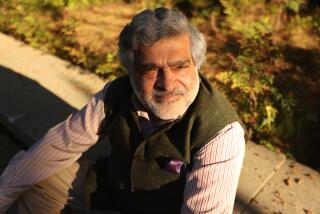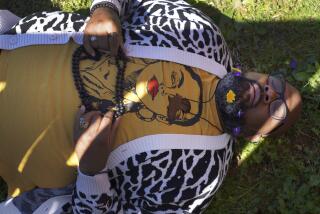Swami Satchidananda, 87; Yoga Master and Guru Preached and Practiced a Life of Spiritual Unity
- Share via
Swami Satchidananda, the yoga master and guru whose message of spiritual unity brought solace to the Woodstock generation and attracted followers from Hollywood to Virginia, died Monday in India. He was 87.
The swami lived in Yogaville, Va., a 1,000-acre community he founded by the Blue Ridge Mountains near Charlottesville in 1979.
He was in his native South India to address a peace conference when he died suddenly from a thoracic aneurysm, a Yogaville representative said.
Brought to America in 1966 by psychedelic artist Peter Max, the swami was part of a wave of Hindu teachers in the 1960s and ‘70s who found among U.S. youth a curiosity about Eastern mysticism, music and meditation. He became known as the “Woodstock guru” after he opened that epochal music festival in 1969 by declaring music “the celestial sound that controls the whole universe.”
He gradually shifted his base of operations from Sri Lanka to the U.S. and opened branches of his Integral Yoga Institute around the world.
Carole King a Disciple
Among his disciples are singer-composer Carole King, who donated 600 acres to his Virginia ashram; jazz pianist Alice Coltrane; and actresses Diane Ladd, Laura Dern and Sally Kirkland. Another adherent is Dr. Dean Ornish, the best-selling author, who said the teachings of the swami inspired his research and program for reversing heart disease through diet and relaxation.
The swami was a tall, lean man in a billowing white beard and saffron robes. Followers often remarked on his penetrating, otherworldly gaze. “When you looked in his eyes,” Max recalled recently of his first meeting with the guru 36 years ago, “nobody was home except an ocean of love.”
The swami loved to fly planes and helicopters and had satellite television installed in his modern house at the ashram. He was fascinated by cameras and would usually be seen carrying the latest models, presents from admirers.
His followers regarded him as a fount of practical wisdom.
Actress Lindsay Crouse recalled a meditation with the swami during which a woman confessed how aggrieved she was by her lack of success. “She said, ‘I’ve really been trying to do good work, make independent films, not commercial, but I just can’t get anywhere with it,’ ” Crouse recalled.
“Well,” the swami replied, “people obviously don’t want that--do something else!”
“He was very down to earth,” Crouse said. “He gave very simple advice, [so simple] it would make you feel sort of silly after a while.”
Born in Chettipalayam in South India in 1914, he was the son of wealthy landowners. As a young man, he worked in his uncle’s auto import business and learned welding. He also worked briefly in India’s film industry as a cameraman and producer.
He married and had children. But when his wife of five years died, he began, at age 28, his spiritual journey. He took the vows of a renunciate and traded his given name of Ramaswamy for Satchidananda, said to mean “existence, knowledge, bliss.”
He studied with some of India’s greatest sages, adopting Swami Sivananda as his guru in 1949. Four years later, he left for Sri Lanka, where he opened a branch of Sivananda’s organization, the Divine Life Society. He remained for several years, opening an orphanage and medical clinic, and joining a movement to welcome untouchables to Hindu temples.
In 1966, Conrad Rooks, a filmmaker, invited Max to Paris to help him with a project, a movie about “the meaning of life.” When Max arrived, he was greeted by Rooks, Ravi Shankar and Swami Satchidananda.
“I didn’t know what a swami was,” Max said. But he was instantly mesmerized by the Indian man with golden eyes. “I just told him, ‘Swami, America needs you desperately to come there.’ All the hippies were running around, experimenting, trying to become sort of enlightened.”
Under a visa identifying him as “Minister of Divine Words,” the swami came for a two-day visit, but wound up staying for the rest of his life. He became a popular yoga teacher in New York City. Within a year, his supporters had bought him a $1-million center on Manhattan’s Upper West Side.
Finding an Inner Peace
His integral yoga teaches Hatha yoga and other methods, as well as meditation, chanting and cleansing practices.
“He was a major figure who helped bring yoga to the West,” said Nora Isaacs, managing editor of the Berkeley-based Yoga Journal. “His underlying message was that every person has peace within them, but it’s all covered up. By doing these practices, you uncover that.”
He reached a massive audience in 1969, in a cow pasture in New York state. Max, his sponsor, knew Michael Lang, one of the organizers of the Woodstock festival, and proposed that the swami open the event.
Sitting on a stage that would be shared by such countercultural icons as Jimi Hendrix, Janis Joplin and the Grateful Dead, the swami challenged the throngs to use “the sacred art of music” to bring peace to the globe.
He attracted a celebrity following that included Mia Farrow, George Harrison and Rascals vocalist Felix Cavaliere. Some of his students became yoga teachers, such as King and Kirk- land, who has taught Bob Dylan, Elia Kazan and Robert DeNiro.
“He was very, very playful, which is why so many celebrities enjoyed being with him,” said Nirmala Heriza, a longtime devotee who now directs the Integral Yoga Center of Los Angeles, as well as a rehabilitation program for heart patients at Cedars-Sinai Medical Center that is based on the swami’s precepts.
Kirkland nearly became a monk after meeting the swami in 1969. She remembered that when she asked him if she should quit show business, he said, “No, no, no, no, no. Your destiny is to be a public person.... Just consider yourself a plainclothes swami.”
“If you met him today, you would feel you were in the presence of a 12-year-old,” Kirkland said. “He had such innocence and joy, and a hysterical sense of humor.”
At the dedication of a $2-million, lotus-shaped temple at the Virginia ashram in 1986, he flew in a helicopter over the site, leaning out to pour holy water over the structure. The festivities included a parade featuring a flame-tossing juggler, monks, priests and rabbis. Leading the procession was a baby elephant named Bubbles.
The lotus shrine is the focal point of the ashram. It features a column of light ascending from a central altar that divides into 12 rays. The rays represent the world’s religions, while the central light symbolizes universal wisdom.
The message, the swami once said, was “not to make one religion out of 12” but to illuminate the central truths at their core. His slogan was “Truth Is One, Paths Are Many.”
“Read the Bible, read the Koran, read the Torah, the Upanishads, the Bhagavad Gita,” the ecumenical guru said. “They all say: ‘Refine yourself. Get out of these definitions.’ It’s the definitions that divide us.”
An estimated 1,500 mourners attended his funeral Thursday in Yogaville. He will be entombed in a sarcophagus beneath a statue of his likeness.
More to Read
Sign up for Essential California
The most important California stories and recommendations in your inbox every morning.
You may occasionally receive promotional content from the Los Angeles Times.











